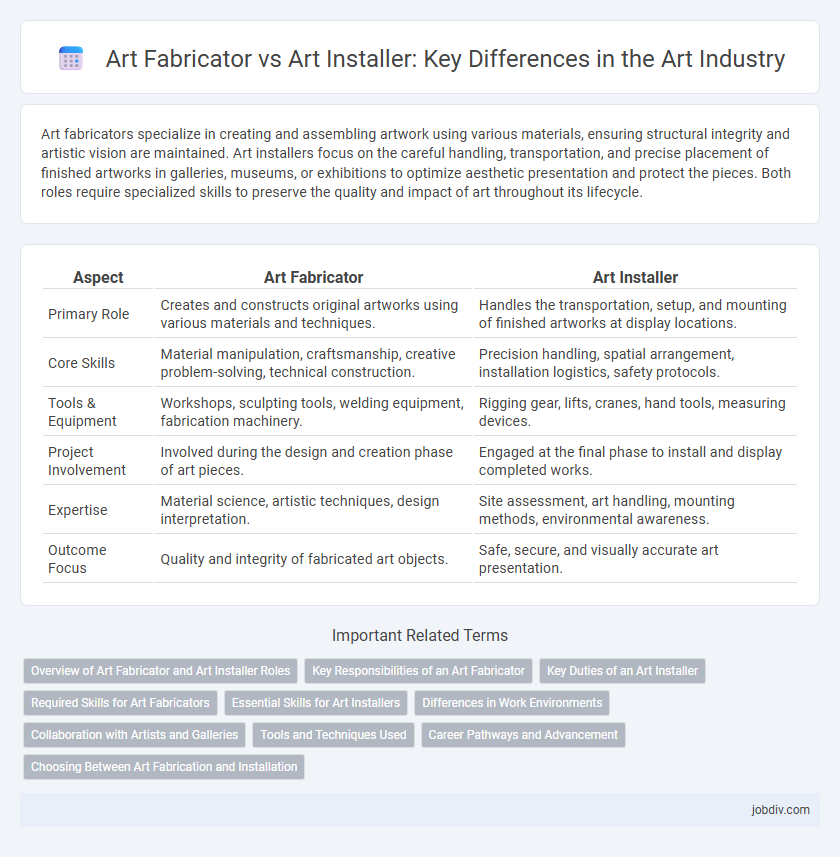Art fabricators specialize in creating and assembling artwork using various materials, ensuring structural integrity and artistic vision are maintained. Art installers focus on the careful handling, transportation, and precise placement of finished artworks in galleries, museums, or exhibitions to optimize aesthetic presentation and protect the pieces. Both roles require specialized skills to preserve the quality and impact of art throughout its lifecycle.
Table of Comparison
| Aspect | Art Fabricator | Art Installer |
|---|---|---|
| Primary Role | Creates and constructs original artworks using various materials and techniques. | Handles the transportation, setup, and mounting of finished artworks at display locations. |
| Core Skills | Material manipulation, craftsmanship, creative problem-solving, technical construction. | Precision handling, spatial arrangement, installation logistics, safety protocols. |
| Tools & Equipment | Workshops, sculpting tools, welding equipment, fabrication machinery. | Rigging gear, lifts, cranes, hand tools, measuring devices. |
| Project Involvement | Involved during the design and creation phase of art pieces. | Engaged at the final phase to install and display completed works. |
| Expertise | Material science, artistic techniques, design interpretation. | Site assessment, art handling, mounting methods, environmental awareness. |
| Outcome Focus | Quality and integrity of fabricated art objects. | Safe, secure, and visually accurate art presentation. |
Overview of Art Fabricator and Art Installer Roles
Art fabricators specialize in transforming artists' concepts into tangible works by utilizing materials such as metal, wood, glass, and plastics, often involving complex technical processes and craftsmanship. Art installers are responsible for the safe and precise placement of artworks in galleries, museums, or public spaces, requiring expertise in handling, mounting, and preservation techniques. Both roles demand collaboration with artists and curators to maintain the integrity and vision of the artwork throughout fabrication and installation stages.
Key Responsibilities of an Art Fabricator
Art fabricators specialize in transforming artists' concepts into tangible works through materials manipulation, structural engineering, and technical expertise. They handle the creation, assembling, and finishing of artworks, ensuring precision and durability while maintaining artistic integrity. Their key responsibilities include collaborating with artists on design feasibility, sourcing materials, and employing advanced fabrication techniques to bring complex sculptures or installations to life.
Key Duties of an Art Installer
Art installers are responsible for the precise placement and secure mounting of artworks in galleries, museums, or private collections, ensuring both aesthetic presentation and preservation. They handle delicate handling, alignment, and sometimes lighting adjustments to enhance the viewer's experience while maintaining the artwork's integrity. Unlike art fabricators who focus on creating the pieces, art installers specialize in the logistical and technical aspects of exhibition setup and deinstallation.
Required Skills for Art Fabricators
Art fabricators require advanced skills in material science, precision fabrication techniques, and problem-solving to transform artistic concepts into durable, high-quality physical pieces. Expertise in tools such as CNC machines, welding equipment, and 3D printers is essential to accurately interpret and construct complex artworks. Strong collaboration skills and attention to detail ensure that the artist's vision is faithfully realized while meeting safety and installation standards.
Essential Skills for Art Installers
Art installers require proficiency in handling diverse materials, precise measurement techniques, and spatial awareness to position artworks accurately according to gallery specifications. Essential skills also include knowledge of rigging systems, art conservation principles, and the ability to interpret curatorial plans for secure and optimal presentation. Strong problem-solving abilities and teamwork are critical to adapt installations to varying environments and ensure the integrity of delicate art pieces.
Differences in Work Environments
Art fabricators typically work in controlled studio or workshop settings equipped with specialized tools and materials necessary for creating, molding, and assembling artworks, often collaborating with artists and designers. In contrast, art installers operate on-site at galleries, museums, or private collections, focusing on the precise placement, mounting, and securing of artworks within varied and sometimes challenging environments. These differing work environments influence not only the physical demands but also the skill sets required for each role.
Collaboration with Artists and Galleries
Art fabricators specialize in transforming artists' concepts into physical works, using advanced materials and techniques to realize precise creative visions. Art installers coordinate closely with galleries and artists to ensure proper handling, placement, and presentation of artworks in exhibition spaces, preserving artistic integrity and enhancing viewer experience. Their collaboration fosters seamless communication and logistical planning, critical for successful installations and exhibitions.
Tools and Techniques Used
Art fabricators employ advanced tools such as CNC machines, 3D printers, welding equipment, and molding materials to create sculptures or complex art pieces from various mediums like metal, resin, and wood. Art installers utilize specialized tools including lifts, dollies, levelers, and custom hanging systems to ensure safe and precise placement of artworks in galleries or exhibitions. Both roles require mastery of materials and techniques, but fabricators focus on creation through fabrication technologies, while installers emphasize handling and positioning using installation tools.
Career Pathways and Advancement
Art fabricators specialize in creating and assembling artworks, often requiring skills in materials science, carpentry, and welding, with career advancement leading to senior fabrication roles or project management. Art installers focus on the precise placement and mounting of artwork in galleries or exhibitions, developing expertise in handling delicate pieces and spatial design, which can lead to supervisory positions or curatorial assistance. Both pathways offer opportunities to collaborate closely with artists and institutions, with progression depending on technical mastery and experience in art handling protocols.
Choosing Between Art Fabrication and Installation
Choosing between art fabrication and installation depends on the project's complexity and specific needs. Art fabricators specialize in creating custom artworks or components using various materials, ensuring precision and durability. Art installers focus on the safe transport, placement, and securing of artworks, requiring expertise in handling delicate or large-scale pieces to maintain their integrity.
Art Fabricator vs Art Installer Infographic

 jobdiv.com
jobdiv.com